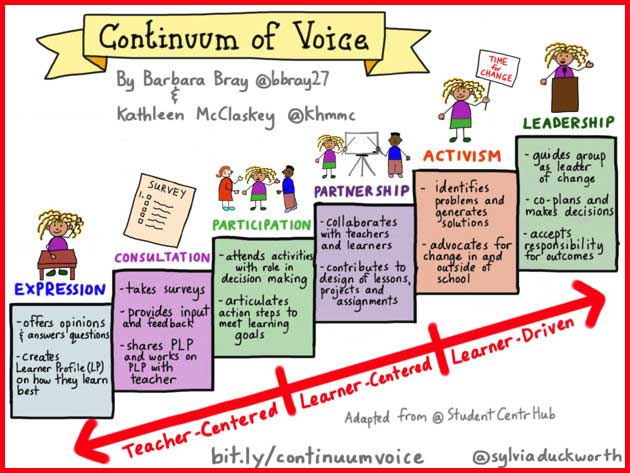5 Ideas for Keeping Students At The Center of Learning #TLTechLive

1) Align learning to student preferences
How are you designing opportunities in alignment with the way students learn best? At the Phoenix Coding Academy they use a tool called Indigo (similar to Thrively or Naviance… aka Myers Briggs for young people). As a result educators and students can use these profiles to customize their school work to ensure what they do best matches the needs indicated in their learning profiles. The profiles also help students see the type of career that might be best matched to their strengths.
2) Relationships are key
When using technology, it is imperative to remember that the relationship between teacher and student is still key. An advantage of technology is that it can replace some of the work typically done by a teacher such as providing instant feedback, lectures on demand. Some administrators see this as an opportunity to pile on the number of students a teacher has. Administrators who understand the importance of relationships know that this shift in responsibilities should result in the teacher being able to provide more time and individual focus on supporting the students in front of them. Models like Big Picture Learning ensure that teachers have very small class loads because only by building relationships can we really meaningfully impact children.
3) Build learning networks
Traditionally teachers with their teacher’s guide in hand had the power to dole out information to their little disciples. That should no longer be the case in our information rich, connected world. Today, the teacher should no longer be at the center of instruction. Instead, the teacher should be guiding and empowering digital learners who are the center of their own learning network aligned with their passions, interests, and abilities. This means supporting students in safely connecting to a network of people who can help guide and support their learning goals. While this can certainly mean people from within the community, with technology there are no geographical boundaries. So this can mean helping them connect with experts, authors, and others who share their interests from around the globe. You can read more about how to do this in the books The Educator’s Guide to Creating Connections and Supporting Student Personal Learning Networks.
4) Give students opportunities to hold leadership roles
Tools and ideas to transform education. Sign up below.
Not only should students be at the center, but students can be empowered to have leadership roles. For example allow students to lead digital citizenship initiatives. Create a student tech support team at your school where students are given leadership roles. Does your school have a leadership team that helps to make important decisions? Make sure students are on that team.
5) Involve students in all aspects of their education
It is essential that we communicate with the people that ultimately will be impacted and give them a platform for input. This means they should be a part of conversations about curriculum design, classroom environment, facilities, purchasing, etc. This isn’t a one time conversation. It is ongoing. Bring everyone to the table at regular intervals to not only to develop a clear plan, but also to discuss issues that come up during implementation and execution and come up with solutions.
Your turn
What do you think? Are there some ideas shared here that exist where you work? If not, why not? Are there some you may be able to introduce? Are there ideas you use that are not mentioned here? What are they?
Lisa Nielsen writes for and speaks to audiences across the globe about learning innovatively and is frequently covered by local and national media for her views on “Passion (not data) Driven Learning,” "Thinking Outside the Ban" to harness the power of technology for learning, and using the power of social media to provide a voice to educators and students. Ms. Nielsen has worked for more than a decade in various capacities to support learning in real and innovative ways that will prepare students for success. In addition to her award-winning blog, The Innovative Educator, Ms. Nielsen’s writing is featured in places such as Huffington Post, Tech & Learning, ISTE Connects, ASCD Wholechild, MindShift, Leading & Learning, The Unplugged Mom, and is the author the book Teaching Generation Text.
Disclaimer: The information shared here is strictly that of the author and does not reflect the opinions or endorsement of her employer.
Lisa Nielsen (@InnovativeEdu) has worked as a public-school educator and administrator since 1997. She is a prolific writer best known for her award-winning blog, The Innovative Educator. Nielsen is the author of several books and her writing has been featured in media outlets such as The New York Times, The Wall Street Journal, and Tech & Learning.
Disclaimer: The information shared here is strictly that of the author and does not reflect the opinions or endorsement of her employer.
